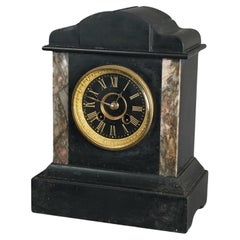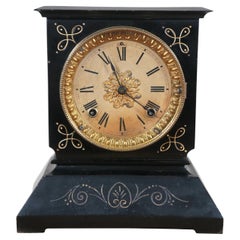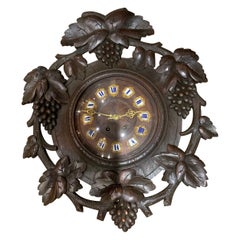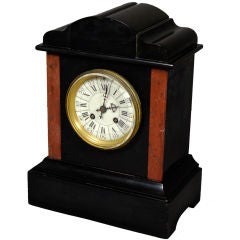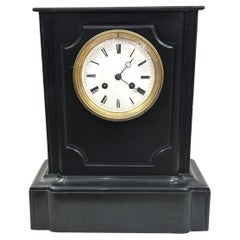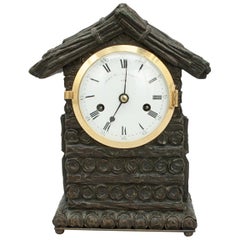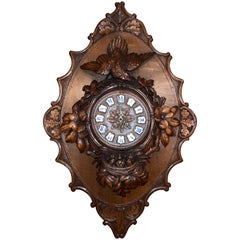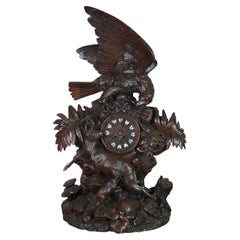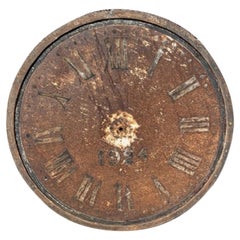Black Antique Clocks
to
47
154
124
206
67
62
47
43
16
12
12
11
8
7
7
6
6
5
4
4
3
3
2
2
1
1
1
1
1
1
1
1
2
2
2
1
1
Sort By
Antique Herschede Egyptian Revival Slate Mantel Clock Circa 1890
By Herschede Clock Co.
Located in Big Flats, NY
An antique Egyptian Revival mantel clock by Herschede offers slate case in architectural form and
Category
Antique Late 19th Century Egyptian Revival Mantel Clocks
Materials
Slate
$760 Sale Price
20% Off
H 11.5 in W 9.25 in D 5.5 in
Rare Antique 19th Century American Victorian Ansonia Cast Iron Mantel Clock 10"
By Ansonia Clock Company
Located in Dayton, OH
Late 19th century black cast iron Ansonia mantel clock. Black lacquered iron case with gold painted
Category
Antique Late 19th Century American Victorian Mantel Clocks
Materials
Brass, Iron
$500 Sale Price
20% Off
H 10.25 in W 9.5 in D 4.75 in
Antique Black Forest hand carved case wall clock
Located in Houston, TX
white and blue enamel. This type carving is considered Black Forest
And is from Switzerland. The clock
Category
Antique Late 19th Century Swiss Wall Clocks
Materials
Oak
Antique French Clock with Porcelain Face
By Japy Frères
Located in Asheville, NC
Handsome antique clock has Roman numerals and marked minutes with detailed hands on porcelain face
Category
Antique 19th Century French Clocks
Materials
Marble, Slate, Iron
Antique French Marble Clock
Located in New York, NY
A circa 1920's French black marble mantel clock.
Measurements:
Height: 15"
Width: 12.5"
Depth: 6"
Category
Vintage 1920s French Mantel Clocks
Materials
Marble
Antique Mantel Clock by Grant, Black Forest Type Design
Located in Oxfordshire, GB
, with black Roman numerals for the hours and Arabic for the five-minute intervals (this type of clock
Category
Antique 1820s British Mantel Clocks
Materials
Bronze
Antique German Black Forest Wall Clock, Circa 1880.
Located in New Orleans, LA
Antique German Black Forest Wall Clock with Carved Bird and Florals, Circa 1880.
Category
Antique Late 19th Century German Wall Clocks
Materials
Wood
Monumental Antique German Black Forest Eagle Chamois Mantel Hunt Clock
Located in Dayton, OH
Monumental 19th century antique German Black Forest mantel clock featuring carved high relief
Category
Antique Mid-19th Century Black Forest Mantel Clocks
Materials
Hardwood
$4,500 Sale Price
52% Off
H 32 in W 22 in D 8 in
Antique Clock Face Rust and Black, 1924, AC-0124
Located in Scottsdale, AZ
Antique clock face rust and black, 1924
Item #: AC-0124
Dimensions: 28.5” Diameter.
Category
20th Century Unknown Wall Clocks
Materials
Metal
Antique Victorian quality marble clock
Located in Ipswich, GB
Antique Victorian quality marble clock having a quality black marble clock with a 8 day French
Category
Antique 19th Century Victorian Mantel Clocks
Materials
Marble, Brass
19th Century Antique Church Clock
Located in Udenhout, NL
Very big and Antique church clock from the 19th Century.
Comes from a churck in Belgium.
(Be aware
Category
Antique 1850s Belgian Wall Clocks
Materials
Iron
French Empire Antique Black Marble and Ormolu Borne Clock by Maniere
By C. Maniere
Located in London, GB
Fine black marble and ormolu mantel clock of borne (antique milestone) form. Superb proportions and
Category
Antique Early 1800s French Empire Mantel Clocks
Materials
Marble, Ormolu
$13,398
H 18.8 in W 9.5 in D 6.75 in
Mixed Media Collage Painting on Antique Clock
Located in Hopewell, NJ
Eye catching and imaginative mixed media wall sculpture having a black antique clock that's
Category
21st Century and Contemporary North American Wall-mounted Sculptures
Materials
Metal
Pretty antique Victorian marble mantle clock
Located in Ipswich, GB
Pretty antique Victorian marble mantle clock, having a quality antique Victorian marble mantle
Category
Antique Early 19th Century Early Victorian Mantel Clocks
Materials
Marble
Outstanding quality large antique mantle clock
Located in Ipswich, GB
Outstanding quality large antique marble mantle clock, Having an outstanding quality marble case
Category
Antique Early 19th Century Early Victorian Mantel Clocks
Materials
Marble
Quality Antique Victorian Marble Mantle Clock
Located in Ipswich, GB
Quality antique Victorian marble mantle clock having black Roman numerals on a cream chapter ring
Category
Antique 19th Century Victorian Mantel Clocks
Materials
Marble, Brass
19th Century Black Marble Mantel Clock
Located in LA CIOTAT, FR
This elegant antique French mantel clock is crafted from exquisite black marble, showcasing
Category
Antique 19th Century French Mantel Clocks
Materials
Marble, Brass
St. Bernard Black Forest Mantle Clock
Located in Coeur d'Alene, ID
Antique Black Forest carved mantle clock having two St. Bernard rescue dogs. One with bell and
Category
Antique Late 19th Century Mantel Clocks
Materials
Wood
Large Antique French Empire Style Bronze and Marble Figural Clock
Located in New York, NY
The large and elegant antique French Empire style bronze and marble figural clock features a
Category
Antique 19th Century French Empire Clocks
Materials
Ormolu, Bronze
Antique Classically Designed Slate Mantle Clock, c1890
Located in Big Flats, NY
Antique Classically Designed Slate Mantle Clock, c1890
Measures - 9" X 13 3/4" X 5 1/4"
Category
Antique Late 19th Century Mantel Clocks
Materials
Slate
$280 Sale Price
20% Off
H 9 in W 13.75 in D 5.25 in
Quality antique Victorian eight day mantle clock
Located in Ipswich, GB
Quality antique Victorian eight day mantle clock having a quality antique Victorian black marble
Category
Antique 19th Century Victorian Mantel Clocks
Materials
Marble
Superb Quality Antique Victorian Marble Mantle Clock
Located in Suffolk, GB
Superb quality antique Victorian marble mantle clock having a black marble case with quality bronze
Category
Antique 19th Century English Victorian Mantel Clocks
Materials
Marble
Antique Victorian Silvered Bronze Horseshoe and Bit Clock, circa 1860's
Located in New Orleans, LA
Antique Victorian silvered bronze horseshoe and bit clock, Circa 1860's.
The piece comes with a
Category
Antique 19th Century English Victorian Clocks
Materials
Bronze
$4,800
H 10 in W 6.5 in D 7.5 in
Antique Tiffany & Co. Slate Mantle Clock Signed 19thC
Located in Big Flats, NY
Antique Tiffany & Co. Slate Mantle Clock Signed 19thC.
8 1/4" x 8 3/8" x 5 3/4".
This is a
Category
Antique 19th Century Mantel Clocks
Materials
Slate
$520 Sale Price
20% Off
H 8.25 in W 8.5 in D 5.75 in
Huge Antique Victorian Era Black Forest Wall Clock or Mirror Frame with Hare
Located in Lisse, NL
antique started its life as a very large clock. It can again made to be either, but one could also turn
Category
Antique Late 19th Century German Black Forest Wall Clocks
Materials
Nutwood
$8,899
H 43.5 in W 28 in D 10 in
Fine Antique 19th Century Marble Mantel Clock
Located in Suffolk, GB
Fine antique Victorian marble mantel clock having a quality marble case with pretty ornate brass
Category
Antique 19th Century French High Victorian Mantel Clocks
Materials
Marble
Fine quality antique Edwardian chinoiserie decorated mantle clock
Located in Ipswich, GB
Fine quality antique Edwardian chinoiserie decorated mantle clock, having a quality antique
Category
Early 20th Century Unknown Chinoiserie Mantel Clocks
Materials
Brass
$1,463
H 7.09 in W 7.88 in D 3.15 in
Antique French Cherub Mantel Clock By Francois Moreau
By Louis & François Moreau
Located in Ongar, GB
Antique French mantel clock by Francois Moreau. Circa 1900. In good working condition.
Please
Category
Antique Early 1900s French Mantel Clocks
Materials
Spelter
Antique Victorian quality marble eight day mantle clock
Located in Ipswich, GB
Antique Victorian quality marble eight day mantle clock having a quality black marble mantle clock
Category
Antique Early 19th Century Victorian Mantel Clocks
Materials
Marble, Brass
Antique Ansonia Neoclassical Figural Swinging Ball Mystery Clock C1890
Located in Big Flats, NY
"D.
This fine antique Ansonia clock features a neoclassical design with a figural representation
Category
Antique 19th Century Neoclassical Mantel Clocks
Materials
Metal
$1,960 Sale Price
20% Off
H 25 in W 5.5 in D 8 in
Outstanding quality large antique Victorian marble mantle clock
Located in Ipswich, GB
Outstanding quality large antique Victorian marble mantle clock. Having an outstanding quality
Category
Antique Early 19th Century Victorian Mantel Clocks
Materials
Marble, Brass
Antique Wooden Mantel Clock with Eagle, Swiss 1900
Located in Berghuelen, DE
Antique Wooden Mantel Clock with Eagle, Swiss 1900
A great carved linden wood mantel clock with a
Category
Antique Late 19th Century German Black Forest Mantel Clocks
Materials
Wood
Antique Neoclassical Slate Mantle Clock with Open Escapement, c1890
Located in Big Flats, NY
Antique Neoclassical Slate Mantle Clock with Open Escapement, c1890
Measures - 9" x 17" x 6 1/4"
Category
Antique Late 19th Century Mantel Clocks
Materials
Slate
$280 Sale Price
20% Off
H 9 in W 17 in D 6.25 in
Antique Malachite, Gilt and Patinated Spelter Mantel Clock
Located in London, GB
This beautiful clock was crafted in France in the late 19th century. The clock is a monument to
Category
Antique Late 19th Century French Neoclassical Mantel Clocks
Materials
Malachite, Spelter
$7,145 Sale Price
20% Off
H 20.08 in W 22.45 in D 8.27 in
Antique Mantel Clock with Herdsman Family, Goats and Cattle
Located in Berghuelen, DE
Antique Mantel Clock with Herdsman Family, Goats and Cattle
A Black Forest wooden carved mantel
Category
Antique Late 19th Century German Black Forest Mantel Clocks
Materials
Wood
Antique Neo-Grec Porcelain and Cast Iron Clock Set
Located in London, GB
Antique Neo-Grec porcelain and cast iron clock set
French, 19th Century
Clock: Height 41cm, width
Category
Antique 19th Century French Neoclassical Mantel Clocks
Materials
Iron
$6,046 Sale Price / set
20% Off
H 16.15 in W 15.75 in D 6.3 in
19th Century Antique Large French Three Piece Clock Set
Located in Suffolk, GB
19th century fine antique large French three piece clock set having a fisherman in period dress
Category
Antique 19th Century French Victorian Mantel Clocks
Materials
Spelter
Large Victorian 19th Century Antique Faux Marble Mantel Clock
Located in Suffolk, GB
Large Victorian 19th century antique faux marble mantel clock having a fantastic architectural
Category
Antique 19th Century Mantel Clocks
Materials
Brass, Enamel, Other
Antique Mantel Clock with Eagle and Chamois Family, ca. 1900
Located in Berghuelen, DE
Antique Mantel Clock with Eagle and Chamois Family, ca. 1900
A large Black Forest wooden carved
Category
Antique Late 19th Century Swiss Black Forest Mantel Clocks
Materials
Wood
Wonderful Antique Victorian quality eight day movement marble clock set
Located in Ipswich, GB
Wonderful Antique Victorian quality eight day movement marble clock set, having a black marble case
Category
Antique Early 19th Century Victorian Mantel Clocks
Materials
Marble
$1,065 / set
H 14.97 in W 13 in D 5.71 in
Unusual shaped antique Victorian quality marble eight day mantle clock
Located in Ipswich, GB
Unusual antique Victorian quality marble eight day mantle clock having a unusual quality antique
Category
Antique Early 19th Century Victorian Mantel Clocks
Materials
Marble
$1,147
H 13.78 in W 13.78 in D 6.3 in
Antique French Egyptian Revival Clock
Located in Scottsdale, AZ
Antique French Egyptian Revival Clock. Beautiful piece purchased in France. Age appropriate wear
Category
Antique 19th Century French Egyptian Revival Table Clocks and Desk Clocks
Materials
Metal
Early 19th Century Antique Bracket Clock by Grimalde & Johnson of London
By Grimaldi & Johnson
Located in Devon, GB
An antique late George III period ebonized bracket clock by Grimalde and Johnson, strand. This
Category
Antique 19th Century British Regency Mantel Clocks
Materials
Wood
$11,611
H 12.75 in W 10 in D 7 in
Large Antique Circular Wall Clock Trade Mark "S"
Located in Bridgeport, CT
With a deep carved and ribbed oak surround. The white dial with black painted Roman numerals and
Category
Antique 19th Century Industrial Wall Clocks
Materials
Oak
Antique American Empire Slate & Marble Clock with Blue Enamel Open Escapement
Located in Big Flats, NY
Antique American Empire Slate & Marble Clock with Blue Enamel Open Escapement, c1910
Measures - 16
Category
Early 20th Century Mantel Clocks
Materials
Slate
$600 Sale Price
20% Off
H 16.75 in W 12 in D 6.75 in
Antique 19th century quality French boulle bracket clock with original bracket
Located in Ipswich, GB
Antique 19th century quality French boulle bracket clock with original bracket, Fantastic quality
Category
Antique Early 19th Century Wall Clocks
Materials
Brass, Ormolu
$5,689
H 22.05 in W 11.03 in D 5.91 in
Antique French Japy Freres Brass Champleve Enameled Cloisonne Mantel Clock
By Japy Frères
Located in Dayton, OH
Antqiue late 19th Century French Japy Freres gilt brass enameled mantel clock featuring
Category
Antique Late 19th Century French Neoclassical Mantel Clocks
Materials
Brass, Enamel
$2,800 Sale Price
20% Off
H 14.75 in W 7 in D 6.25 in
Antique E. Ingraham & Co. Candy Stripe Inlay Mantel Clock 1871
By Ingraham
Located in Bridgeport, CT
An antique mantel clock by E. Ingraham & Co. with candy stripe inlay, spring driven movement, brass
Category
Antique 19th Century North American Victorian Mantel Clocks
Materials
Metal
Fine quality antique marquetry inlaid mantle clock by Thomas A Paris
Located in Ipswich, GB
Fine quality antique 19th century marquetry inlaid mantle clock by Thomas A Paris, having a
Category
Antique Early 19th Century Mantel Clocks
Materials
Brass
$1,147
H 10.63 in W 6.7 in D 4.73 in
19th Century Black Forest Carved Mantle Clock Spill Vase Garniture Set
Located in Forney, TX
A magnificent antique Black Forest carved three piece mantel clock and garniture set. circa 1880
Category
Antique Late 19th Century European Black Forest Mantel Clocks
Materials
Glass, Wood
$14,500
H 20.25 in W 30 in D 7.5 in
Antique Cabin Antler Wall Clock with Deer Head Austria ca. 1900
Located in Berghuelen, DE
Antique Cabin Antler Wall Clock with Deer Head Austria ca. 1900
A large rustic antler wall clock
Category
Antique Late 19th Century Austrian Black Forest Wall Clocks
Materials
Plaster, Wood, Antler
$5,745
H 45.28 in W 18.12 in D 12.6 in
18th Century Antique Georgian Ebonized Bracket Clock by William Scafe of London
By William Scafe
Located in Devon, GB
A good quality antique, ebonized brass dial bracket clock by this 18th century 'maker of repute
Category
Antique 18th Century English Georgian Mantel Clocks
Materials
Brass
$20,338
H 20.48 in W 10.24 in D 6.7 in
Antique French Bronze & Marble Three-Piece Mantel Set Clock Napoleon III
Located in Labrit, Landes
Napoleon III French two marbles mantel clock late 19th century circa 1890.
Set of a clock and two
Category
Antique Late 19th Century French Napoleon III Mantel Clocks
Materials
Marble, Brass
$2,527 / set
H 18.51 in W 5.91 in D 14.97 in
Antique Jade and Silvered Bronze Mantel Clock Retailed by Yamanaka & Co.
Located in New York, US
Our lovely portico style mantel clock, retailed by Yamanaka & Company Ltd. in New York in the early
Category
Early 20th Century Japanese Japonisme Mantel Clocks
Materials
Jade, Metal
$38,000
H 11.5 in W 23 in D 7.5 in
Large French 19th Century Black and Green Marble Clock Garniture
Located in LA CIOTAT, FR
This exceptional Napoleon III period mantel clock set, dating to the late 19th century, exudes
Category
Antique 19th Century French Napoleon III Mantel Clocks
Materials
Marble, Bronze
$2,780 / set
H 18.71 in W 14.97 in D 5.91 in
Antique Cabin Antler Wall Clock with Deer and Chamois Austria ca. 1900
Located in Berghuelen, DE
Antique Cabin Antler Wall Clock with Deer and Chamois Austria ca. 1900
A great rustic antler wall
Category
Antique Late 19th Century Austrian Black Forest Wall Clocks
Materials
Wood, Plaster, Antler
$4,465
H 26.38 in W 13.39 in D 7.09 in
Antique French Art Deco Figural Spelter & Onyx Garniture Mantel Clock Set Uriano
Located in Dayton, OH
An exceptional and difficult to find Art Deco Garniture Clock Set depicting a young lady looking
Category
Early 20th Century French Art Deco Mantel Clocks
Materials
Onyx, Spelter
$1,440 Sale Price / set
20% Off
H 13.5 in W 22 in D 6 in
Antique Mora Clock Swedish Gold Black Early 1800s Chinoiserie Painted Original
Located in Lewes, England
Antique Swedish Mora clock from early 1800s in probable original paint with a great decorative
Category
Antique Early 19th Century Swedish Gustavian Grandfather Clocks and Long...
Materials
Wood
$5,723 Sale Price
40% Off
H 84.65 in W 19.69 in D 9.85 in
- 1
Get Updated with New Arrivals
Save "Black Antique Clocks", and we’ll notify you when there are new listings in this category.
Black Antique Clocks For Sale on 1stDibs
Find a variety of black antique clocks available on 1stDibs. Frequently made of metal, wood and stone, all black antique clocks available were constructed with great care. Black antique clocks have long been popular, with older editions for sale from the 18th Century and newer versions made as recently as the 20th Century. Black antique clocks are generally popular furniture pieces, but Victorian, Art Nouveau and Empire styles are often sought at 1stDibs. There have been many well-made black antique clocks over the years, but those made by Albert-Ernest Carrier-Belleuse, Bradley & Hubbard and C. Maniere are often thought to be among the most beautiful.
How Much are Black Antique Clocks?
Prices for black antique clocks start at $186 and top out at $40,000 with the average selling for $2,685.
Questions About Black Antique Clocks
- 1stDibs ExpertApril 5, 2022Check the clock for a manufacturer’s mark or label. Once you have this, you should be able to look up the clock’s brand to see if it is French in origin. A clock is considered antique once it is 100 years old. A professional can also help verify the origin of your clock. Shop an array of expertly vetted antique clocks on 1stDibs.
- How can I spot an antique clock?1 Answer1stDibs ExpertApril 5, 2022To spot whether or not a clock is antique, note if the clockmaker’s name or company is engraved near the center face of the dial. A paper label may also be pasted on the back of the clock. You can shop a collection of expertly vetted antique clocks from some of the world’s top sellers on 1stDibs.
- 1stDibs ExpertOctober 26, 2021An antique bracket clock refers to a portable spring-driven pendulum table clock created in the 17th and 18th centuries. These clocks were equipped with convenient carrying handles and were housed usually in rectangular cases. Shop a collection of antique and vintage bracket clocks from some of the world’s top dealers on 1stDibs.
- 1stDibs ExpertFebruary 27, 2024To identify your antique clock, search for markings on the back of its movement or case. Once you have located these marks, use trusted online resources to determine who the maker is. From there, you can continue your research to learn more about your clock's age, style and other characteristics. An expert appraiser or antiques dealer can also assist you with identification. Find a wide range of antique clocks on 1stDibs.
- 1stDibs ExpertApril 5, 2022Franz Anton Ketterer is believed to be the German clockmaker who invented the cuckoo clock, and he is also one of the founding fathers of the Black Forest clockmaking. Today there are many cuckoo clocks, but to be deemed an authentic Black Forest cuckoo is an honor that is bestowed to only those clocks where every essential part is handmade exclusively in the Black Forest region of Germany. Shop a collection of cuckoo clocks from some of the world’s top sellers on 1stDibs.
- 1stDibs ExpertFebruary 17, 2023To know if an antique clock is valuable, you'll typically need to have the piece assessed by a certified appraiser or an experienced antiques dealer. The maker and style of the clock will help determine its value (an early American clockmaker’s antique grandfather model, featuring an oak case and decorative carvings, may be very interesting to collectors, for example). Overall condition of your clock also plays a role. Generally, clocks that still work are worth more than those that require repairs. On 1stDibs, find a selection of antique, vintage and modern clocks.
- 1stDibs ExpertSeptember 16, 2024Yes, some old antique clocks may be worth something. Many collectors look for clocks produced by certain manufacturers, such as the Ansonia Clock Company, the Seth Thomas Clock Company, Jaeger-LeCoultre and the Chelsea Clock Company. In addition to the maker, the type, materials, style and condition of the clock influence its value. Generally, clocks that remain in good working order are worth more than those in need of repairs and restorations. To find out how much your clock may be worth, consult a certified appraiser or experienced antique dealer. On 1stDibs, explore a large collection of antique clocks.
More Ways To Browse
Lenzkirch Mantel Clock
Slate Mantle
Ansonia Brass Mantel Clock
Chamois Head
Leaping Stag
Paisley Porcelain
Pinwheel Clock
Cuckoo Clock Swiss
Tubular Clock
Winterhalder And Hofmeier Antique Clocks
Winterhalder And Hofmeier
Yamanaka And Co
Antique Wind Chimes
Automata Clock
Black Forest Swiss Cuckoo Clocks
Foundry Wheel
Pheasant Clock
Roman Soldier Clock
